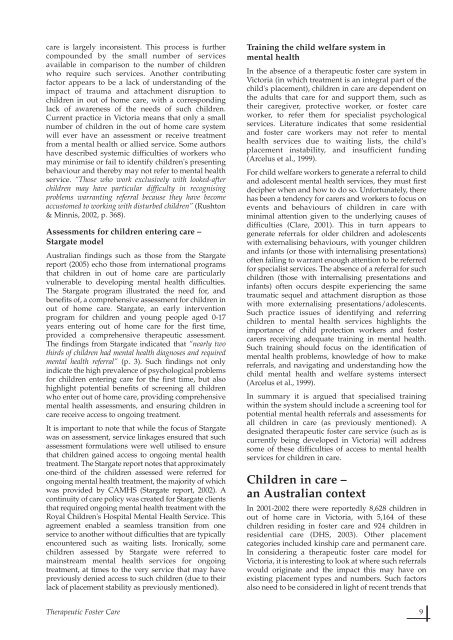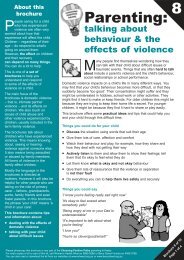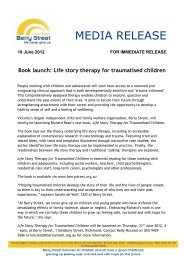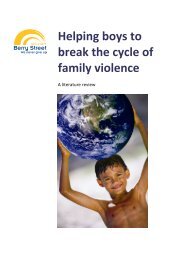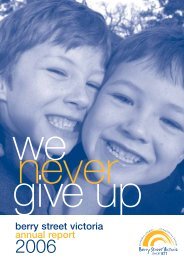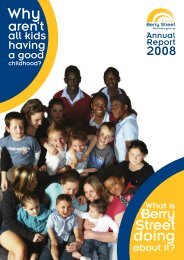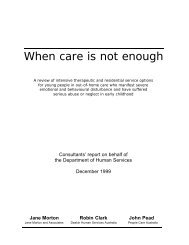Therapeutic foster care - Berry Street Childhood Institute
Therapeutic foster care - Berry Street Childhood Institute
Therapeutic foster care - Berry Street Childhood Institute
Create successful ePaper yourself
Turn your PDF publications into a flip-book with our unique Google optimized e-Paper software.
<strong>care</strong> is largely inconsistent. This process is further<br />
compounded by the small number of services<br />
available in comparison to the number of children<br />
who require such services. Another contributing<br />
factor appears to be a lack of understanding of the<br />
impact of trauma and attachment disruption to<br />
children in out of home <strong>care</strong>, with a corresponding<br />
lack of awareness of the needs of such children.<br />
Current practice in Victoria means that only a small<br />
number of children in the out of home <strong>care</strong> system<br />
will ever have an assessment or receive treatment<br />
from a mental health or allied service. Some authors<br />
have described systemic difficulties of workers who<br />
may minimise or fail to identify children's presenting<br />
behaviour and thereby may not refer to mental health<br />
service. “Those who work exclusively with looked-after<br />
children may have particular difficulty in recognising<br />
problems warranting referral because they have become<br />
accustomed to working with disturbed children” (Rushton<br />
& Minnis, 2002, p. 368).<br />
Assessments for children entering <strong>care</strong> –<br />
Stargate model<br />
Australian findings such as those from the Stargate<br />
report (2005) echo those from international programs<br />
that children in out of home <strong>care</strong> are particularly<br />
vulnerable to developing mental health difficulties.<br />
The Stargate program illustrated the need for, and<br />
benefits of, a comprehensive assessment for children in<br />
out of home <strong>care</strong>. Stargate, an early intervention<br />
program for children and young people aged 0-17<br />
years entering out of home <strong>care</strong> for the first time,<br />
provided a comprehensive therapeutic assessment.<br />
The findings from Stargate indicated that “nearly two<br />
thirds of children had mental health diagnoses and required<br />
mental health referral” (p. 3). Such findings not only<br />
indicate the high prevalence of psychological problems<br />
for children entering <strong>care</strong> for the first time, but also<br />
highlight potential benefits of screening all children<br />
who enter out of home <strong>care</strong>, providing comprehensive<br />
mental health assessments, and ensuring children in<br />
<strong>care</strong> receive access to ongoing treatment.<br />
It is important to note that while the focus of Stargate<br />
was on assessment, service linkages ensured that such<br />
assessment formulations were well utilised to ensure<br />
that children gained access to ongoing mental health<br />
treatment. The Stargate report notes that approximately<br />
one-third of the children assessed were referred for<br />
ongoing mental health treatment, the majority of which<br />
was provided by CAMHS (Stargate report, 2002). A<br />
continuity of <strong>care</strong> policy was created for Stargate clients<br />
that required ongoing mental health treatment with the<br />
Royal Children's Hospital Mental Health Service. This<br />
agreement enabled a seamless transition from one<br />
service to another without difficulties that are typically<br />
encountered such as waiting lists. Ironically, some<br />
children assessed by Stargate were referred to<br />
mainstream mental health services for ongoing<br />
treatment, at times to the very service that may have<br />
previously denied access to such children (due to their<br />
lack of placement stability as previously mentioned).<br />
Training the child welfare system in<br />
mental health<br />
In the absence of a therapeutic <strong>foster</strong> <strong>care</strong> system in<br />
Victoria (in which treatment is an integral part of the<br />
child's placement), children in <strong>care</strong> are dependent on<br />
the adults that <strong>care</strong> for and support them, such as<br />
their <strong>care</strong>giver, protective worker, or <strong>foster</strong> <strong>care</strong><br />
worker, to refer them for specialist psychological<br />
services. Literature indicates that some residential<br />
and <strong>foster</strong> <strong>care</strong> workers may not refer to mental<br />
health services due to waiting lists, the child's<br />
placement instability, and insufficient funding<br />
(Arcelus et al., 1999).<br />
For child welfare workers to generate a referral to child<br />
and adolescent mental health services, they must first<br />
decipher when and how to do so. Unfortunately, there<br />
has been a tendency for <strong>care</strong>rs and workers to focus on<br />
events and behaviours of children in <strong>care</strong> with<br />
minimal attention given to the underlying causes of<br />
difficulties (Clare, 2001). This in turn appears to<br />
generate referrals for older children and adolescents<br />
with externalising behaviours, with younger children<br />
and infants (or those with internalising presentations)<br />
often failing to warrant enough attention to be referred<br />
for specialist services. The absence of a referral for such<br />
children (those with internalising presentations and<br />
infants) often occurs despite experiencing the same<br />
traumatic sequel and attachment disruption as those<br />
with more externalising presentations/adolescents.<br />
Such practice issues of identifying and referring<br />
children to mental health services highlights the<br />
importance of child protection workers and <strong>foster</strong><br />
<strong>care</strong>rs receiving adequate training in mental health.<br />
Such training should focus on the identification of<br />
mental health problems, knowledge of how to make<br />
referrals, and navigating and understanding how the<br />
child mental health and welfare systems intersect<br />
(Arcelus et al., 1999).<br />
In summary it is argued that specialised training<br />
within the system should include a screening tool for<br />
potential mental health referrals and assessments for<br />
all children in <strong>care</strong> (as previously mentioned). A<br />
designated therapeutic <strong>foster</strong> <strong>care</strong> service (such as is<br />
currently being developed in Victoria) will address<br />
some of these difficulties of access to mental health<br />
services for children in <strong>care</strong>.<br />
Children in <strong>care</strong> –<br />
an Australian context<br />
In 2001-2002 there were reportedly 8,628 children in<br />
out of home <strong>care</strong> in Victoria, with 5,164 of these<br />
children residing in <strong>foster</strong> <strong>care</strong> and 924 children in<br />
residential <strong>care</strong> (DHS, 2003). Other placement<br />
categories included kinship <strong>care</strong> and permanent <strong>care</strong>.<br />
In considering a therapeutic <strong>foster</strong> <strong>care</strong> model for<br />
Victoria, it is interesting to look at where such referrals<br />
would originate and the impact this may have on<br />
existing placement types and numbers. Such factors<br />
also need to be considered in light of recent trends that<br />
<strong>Therapeutic</strong> Foster Care 9


